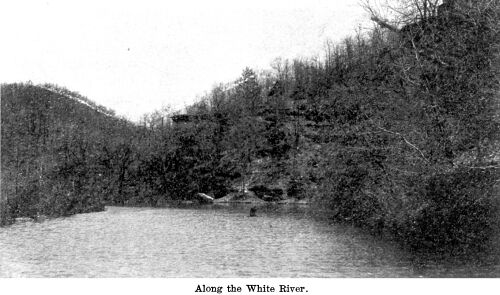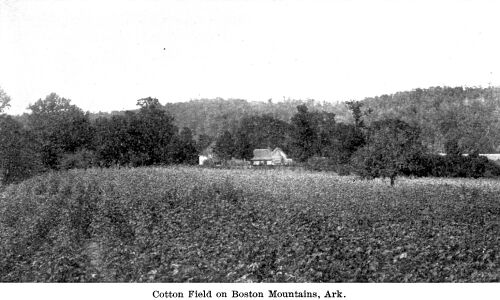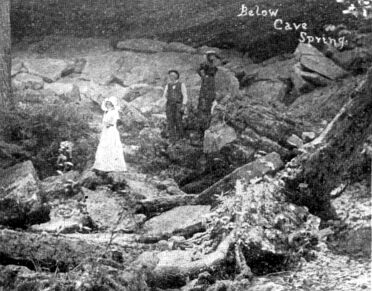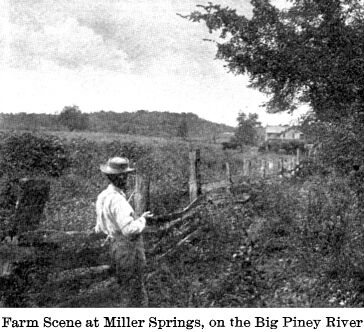|
A LITTLE JOURNEY INTO
ARKANSAS.
BY JOHN H. RAFTERY.
It has been my fortune during the past year to spend some months
in the famous fruit regions of Michigan and therefore to know,
at first hand, something of the native resources of that district
and something of the incessant endeavor which has made it famous.
The climate is rigorous in spring and winter, often harsh even
in summer, and in the autumn as whimsical as a woman's moods.
Its beauty—and it IS beautiful—has in it the sting,
the poignancy, the threats of the moist winds that whip from the
great inland seas which almost surround the state, teasing the
nights with chilly shrillings even in summer, and withering the
face of nature in the autumn before the Indian summer days of
more southerly states have felt the tang of the first frost.
 And yet the
huddled farmers of that widely praised fruit region of Michigan
cling to their small holdings of land with jealous devotion. Something
of the Dutch thrift is in their blood; they toil and figure and
lay awake o' nights, but they seldom sell out. They have at times
pests of insects and visitations of blight which destroy some
of their profits, but they stick manfully to their tasks and hold
values high. Living is costly, for lumber and coal, cattle and
corn are scarce and there the winter bites with fangs of steel.
Fifty dollars will not buy a good acre of fruit land in the Michigan
belt. The canny husbandmen are wedded to their homes, their farms.
They have through the generations and through years of harsh experiences,
adapted themselves to the hard accessories of their northern climate
and they are happy, prosperous and contented. I think it is well
for then that they are a home-keeping race. And yet the
huddled farmers of that widely praised fruit region of Michigan
cling to their small holdings of land with jealous devotion. Something
of the Dutch thrift is in their blood; they toil and figure and
lay awake o' nights, but they seldom sell out. They have at times
pests of insects and visitations of blight which destroy some
of their profits, but they stick manfully to their tasks and hold
values high. Living is costly, for lumber and coal, cattle and
corn are scarce and there the winter bites with fangs of steel.
Fifty dollars will not buy a good acre of fruit land in the Michigan
belt. The canny husbandmen are wedded to their homes, their farms.
They have through the generations and through years of harsh experiences,
adapted themselves to the hard accessories of their northern climate
and they are happy, prosperous and contented. I think it is well
for then that they are a home-keeping race.
I left Michigan in September, when the winds that rush hither
and thither across the peninsula have in them those buffetings
that make the bones ache and numb the fingers that would dally
with rod and reel. And within a few days I was on the southern
slope of the Boston mountains, in Crawford county, Arkansas, with
a pungent south wind blowing in my face and the wine of a matchless
autumn day stirring my blood. I have lived in Colorado, where
the mountains, vast and cold, in winter look like the rust-brown
fragments of iron desolation; I have fished in Tahoe in the Sierras
in the fall when the whole world seemed plumed with mourning timbers,
scarred with rushing mountain rivers and innocent of drill or
plow. I have stood at the measureless rim of that "inferno,
swathed in soft celestial fires," in Arizona, where veteran
travelers are mute and terrified in the presence of such pitiless
immensity. And in all of these mountains, in all the splendors
of their titanic size, in all the mysteries of their wan abysses,
I have never said "Here could be my home!"
 But that is
what one says, standing upon the verdure-clad mountains of Northwestern
Arkansas, looking across the billowing plateaus of Crawford, Washington,
Benton and Sebastian counties. There is a winsome tenderness about
that region that is not all of the atmosphere, nor all of the
magical beauty of the scenery, nor yet all of the bourgeoning
sod, but, I guess, some subtle blending of all these, some feat
of Nature's necromancy, some spirit of the earth, the sky and
air that springs, sun-touched, from the matchless alembic of those
hill-encinctured vales. Here could be my home, you say, looking
from hill to hill through the gold-gray haze of the gentle Indian
summer; here could be my home, you think, when the frost is in
the dry, brisk air of winter like courage in the nostrils of a
boy, and the hills stand 'round about the sheltered valleys so
that you forget the blight of the blizzards in the northern states;
this could be my home, you say , again in spring, when the sap
is stirring and again when the golden days of summer come crowding
on with fruits and flowers and grains that are ripening before
the frost is melted in the backward regions of the north. But that is
what one says, standing upon the verdure-clad mountains of Northwestern
Arkansas, looking across the billowing plateaus of Crawford, Washington,
Benton and Sebastian counties. There is a winsome tenderness about
that region that is not all of the atmosphere, nor all of the
magical beauty of the scenery, nor yet all of the bourgeoning
sod, but, I guess, some subtle blending of all these, some feat
of Nature's necromancy, some spirit of the earth, the sky and
air that springs, sun-touched, from the matchless alembic of those
hill-encinctured vales. Here could be my home, you say, looking
from hill to hill through the gold-gray haze of the gentle Indian
summer; here could be my home, you think, when the frost is in
the dry, brisk air of winter like courage in the nostrils of a
boy, and the hills stand 'round about the sheltered valleys so
that you forget the blight of the blizzards in the northern states;
this could be my home, you say , again in spring, when the sap
is stirring and again when the golden days of summer come crowding
on with fruits and flowers and grains that are ripening before
the frost is melted in the backward regions of the north.
Now, if I happened to be a Michigan fruit farmer, or any kind
of a farmer, I'd be tempted to sell out, pack up and come to Arkansas,
and the wonder of it all is that, in spite of its almost unequaled
climate, its rare beauty and absolutely incomparable fructivity,
these northwestern counties of Arkansas have not yet reached the
tenth part of their possibilities, have not known one-seventh
of the population which their teeming, fields, ore-charged mountains
and matchless fruit lands could well sustain. In Crawford county
alone there are 400,000 acres, and if the 22,000 people living
within its borders were scattered equally throughout its expanse,
there would be but one person on every twenty acres. Similar conditions
prevail in the other counties of this singularly beautiful region,
and even now the great volume of emigration which passes annually
over the Frisco System to the western and southwestern wonderland,
of Oklahoma, Texas and Indian Territory pauses not for the no
less salubrious, equally fertile but far more beautiful farm and
orchard lands of Northwestern Arkansas.
It has been said that in Southern California they sell climate
by the acre and certainly they get good prices for it. In the
rich farming districts of the north you buy land without reference
to atmospheric conditions. In the semi-arid regions you must supply
water for agriculture by artifice. In the cold regions you must
combat the rigors of nature by artifice, too. But in Arkansas,
especially in those upper altitudes, those radiant reaches of
the hill-district, you will find a climate that, is not surpassed
in America, a soil that has no superior for fruit, for grain and
for every flower, forage, feed or fabric plant that grows in the
temperate and semi-tropic zones. When you buy an acre of land,
the cubic acre of atmosphere that is "thrown in" is
neither the brass-blue rainless air of the desert nor the storm-laden,
marrow-piercing climate of the north.
 I'm not sure
that the average farmer "figures" much on climate. The
masculine fruitraiser is apt to be satisfied if he nourishes either
by the sweat of his brow or the frost-bite of his ears. But if
he can flourish with less labor and without encountering the frozen
face, what's the use of remaining a martyr? Benton county, Arkansas,
for instance, is said by fruit experts to be capable of producing
more apples of a uniformly high quality, than any similar area
in the United States. And yet it has not attained more than one-tenth
of its limitations in this single particular! Last year the county
marketed 9,000 crates of strawberries, delivering them in northern
markets from two weeks to two months earlier than rival sections
of even the South, and at a profit not excelled in any berry-raising
district. The county might just as easily have marketed ninety
thousand crates, because the demand for the early strawberries
of Arkansas is unlimited, their fame is established and the accessible
markets are expanding more rapidly than the supply. Land is more
than fifty per cent cheaper, on an average, than the fruit lands
of Michigan; the natural precipitation of moisture is greater
than in the fruit belt of Texas, the number of rivers and springs
of pure water is greater than in any other Southern state, and
yet the climate is as equable and as healthy as in the sun-bathed
valleys of the Red river. I'm not sure
that the average farmer "figures" much on climate. The
masculine fruitraiser is apt to be satisfied if he nourishes either
by the sweat of his brow or the frost-bite of his ears. But if
he can flourish with less labor and without encountering the frozen
face, what's the use of remaining a martyr? Benton county, Arkansas,
for instance, is said by fruit experts to be capable of producing
more apples of a uniformly high quality, than any similar area
in the United States. And yet it has not attained more than one-tenth
of its limitations in this single particular! Last year the county
marketed 9,000 crates of strawberries, delivering them in northern
markets from two weeks to two months earlier than rival sections
of even the South, and at a profit not excelled in any berry-raising
district. The county might just as easily have marketed ninety
thousand crates, because the demand for the early strawberries
of Arkansas is unlimited, their fame is established and the accessible
markets are expanding more rapidly than the supply. Land is more
than fifty per cent cheaper, on an average, than the fruit lands
of Michigan; the natural precipitation of moisture is greater
than in the fruit belt of Texas, the number of rivers and springs
of pure water is greater than in any other Southern state, and
yet the climate is as equable and as healthy as in the sun-bathed
valleys of the Red river.
The railroad, educational and social progression of this portion
of Arkansas are already years ahead of the tributary population.
There are colleges and academies at Bentonville, Ropers, Pea Ridge,
Mason Valley, Siloam Springs, Gentry and other towns of Benton
county and more than a dozen daily newspapers. A hundred public
and private schools offer educational facilities that would not
be overtaxed by an immediate access of 25,000 people.
 It is not
easy to understand why emigrants seeking for cheap lands of proved
fructivity will "jump over" a region so singularly blessed
with every gift of nature, to go further and perhaps fare worse.
If you would write to Mr. Berkely Neal, Van Buren, Crawford county,
he would send you a mass of information well calculated to astonish
these who do not know that the berry farmers around Van Buren
last year netted more than $15,000 from the strawberries sold
in that town alone. There are as yet no authentic figures as to
the quantities of apples, peaches, pears, cherries, grapes and
other small fruits raised in these northwestern counties of the
state, but it is a matter of record that at every exhibition,
fair, exposition or horticultural display in which the growers
of this section have exhibited the examples shown have outranked
all others in point of QUALITY. In perfect texture, in color,
in flavor, in freedom from scars and diseases, the Arkansas apple
is, par excellence, the champion of the world. It is not
easy to understand why emigrants seeking for cheap lands of proved
fructivity will "jump over" a region so singularly blessed
with every gift of nature, to go further and perhaps fare worse.
If you would write to Mr. Berkely Neal, Van Buren, Crawford county,
he would send you a mass of information well calculated to astonish
these who do not know that the berry farmers around Van Buren
last year netted more than $15,000 from the strawberries sold
in that town alone. There are as yet no authentic figures as to
the quantities of apples, peaches, pears, cherries, grapes and
other small fruits raised in these northwestern counties of the
state, but it is a matter of record that at every exhibition,
fair, exposition or horticultural display in which the growers
of this section have exhibited the examples shown have outranked
all others in point of QUALITY. In perfect texture, in color,
in flavor, in freedom from scars and diseases, the Arkansas apple
is, par excellence, the champion of the world.
Passing southward into Washington county, with its 890 square
miles, the paucity of population in this wondrous region becomes
even more apparent and more astonishing. There are today more
than twenty-five thousand acres of Government lands in this county
open to homesteading, and in most cases bearing timber that is
worth twice the initial cost of acquiring and perfecting a title.
Upon its alluvial soil every cereal known to the temperate latitude
will prosper. Washington county is called the "grain belt"
of Arkansas because its fields will yield 50 bushels of corn,
20 bushels of wheat or 40 bushels of oats on every acre so planted.
In addition to its cereal productivity there are thousands of
acres of fruit lands as perfectly adapted for orchards as can
be found in the world. Concord, Norton's Virginia, Neosho and
Delaware grapes seem to surpass the best performances of their
native soils when once installed in the favorable vinelands of
Washington county.
 Sebastian county,
further south, is richer in mineral endowments than any similar
area of the southwest. Fort Smith, its chief city, has a population
of more than 20,000. It is a hive of factories and founderies,
and yet one of the comeliest, cleanest manufacturing towns in
this country. The coals of Sebastian county, like the apples of
the state, excel all others in quality. They are smokeless. The
Quartermaster General of the United States officially reports
that the heating capabilities of Sebastian county coal are from
25 to 100 per cent greater than any other in the world with the
exception of the Pocahontas coal of West Virginia. The available
supply, it not inexhaustible, is so vast that the output of its
mines has made no perceptible impression upon the deposits already
surveyed. But the mineral wealth of this county has subtracted
nothing from its agricultural and horticultural endowments. It
yield cotton and wheat, corn and potatoes, of the highest quality
and the greatest profusion. It has true forests, including almost
every timber known to the middle timber regions. Its topography
is the warrant for, and the explanation of, its high sanitary
rating. Sebastian county,
further south, is richer in mineral endowments than any similar
area of the southwest. Fort Smith, its chief city, has a population
of more than 20,000. It is a hive of factories and founderies,
and yet one of the comeliest, cleanest manufacturing towns in
this country. The coals of Sebastian county, like the apples of
the state, excel all others in quality. They are smokeless. The
Quartermaster General of the United States officially reports
that the heating capabilities of Sebastian county coal are from
25 to 100 per cent greater than any other in the world with the
exception of the Pocahontas coal of West Virginia. The available
supply, it not inexhaustible, is so vast that the output of its
mines has made no perceptible impression upon the deposits already
surveyed. But the mineral wealth of this county has subtracted
nothing from its agricultural and horticultural endowments. It
yield cotton and wheat, corn and potatoes, of the highest quality
and the greatest profusion. It has true forests, including almost
every timber known to the middle timber regions. Its topography
is the warrant for, and the explanation of, its high sanitary
rating.
These are but a few of the facts and salient characteristics
of a section of Arkansas that is, I believe, the rarest combination
of beautiful scenery, good weather and certain utility, in the
United States. I am told that there are other portions of the
state that equal if they do not surpass the four counties which
I have briefly mentioned in this writing. I believe it, though
I can't prove it. I know that the statements I have made seem
tame and trite in print after a short visit to the territory itself.
But out of it all I would like to convey some measure of the impression
made upon an experienced traveler, by the uniquely gentle beauty
of its contour, the caressing tenderness of its sky and air, the
alluring commingling of grandeur with simplicity, of freedom and
domesticity that distinguishes this portion of Arkansas from any
other section of the United States.
Frisco System | Stories Page
| Contents Page
|







